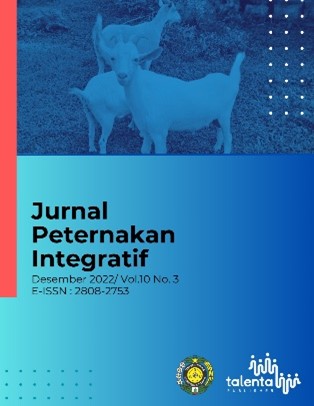Maggot nutrition content in various growing media (vegetable, fruit, and food processing industry): fish flour substitution
DOI:
https://doi.org/10.32734/jpi.v10i3.9455Keywords:
fermentation, food processing industrial waste, fruit, hermetia illucens, nutritional contentAbstract
Vegetable, fruit, and food processing industrial waste has a low nutritional content. The quality of the nutritional content is improved by processing it through fermentation. The study was conducted experimentally using a completely randomized design (CRD) factorial pattern. There were two factors (3 x 3), namely Factor I various maggot growing media (D1 = mustard greens, cabbage, and cauliflower leaves, D2 = banana, pineapple, and papaya, D3 = coconut dregs, tofu dregs, and cassava waste ) and Factor II fermentation time (L1 = 2 days, L2 = 4 days and L3 = 6 days), with three replications. The parameters of this study consisted of the nutritional content of maggot in the form of water content, dry matter, crude protein, crude fiber, crude fat, and ash. The results showed that various maggot-growing media had a significant effect (P<0.05) on the ash content and a very significant effect (P<0.01) on crude protein. No significant effect (P>0.05) was found on moisture content, dry matter, crude fiber, and crude fat. The duration of fermentation of maggot growing media had a significant effect (P<0.05) on crude protein and crude fat but had no significant effect (P>0.05) on moisture content, dry matter, ash content, and crude fiber. There was an interaction between various types of waste and the duration of fermentation of the media on the protein content of maggot. Still, there was no interaction with the water content, dry matter, crude fiber, crude fat, and ash.
Downloads
Downloads
Published
Issue
Section
License
Copyright (c) 2022 Jurnal Peternakan Integratif

This work is licensed under a Creative Commons Attribution-ShareAlike 4.0 International License.
The Authors submitting a manuscript do so on the understanding that if accepted for publication, copyright of the article shall be assigned to Jurnal Peternakan Integratif as well as TALENTA Publisher Universitas Sumatera Utara as the publisher of the journal.
Copyright encompasses exclusive rights to reproduce and deliver the article in all forms and media. The reproduction of any part of this journal, its storage in databases and its transmission by any form or media, will be allowed only with written permission from Jurnal Peternakan Integratif.
The Copyright Transfer Form can be downloaded here.
The copyright form should be signed originally and sent to the Editorial Office in the form of original mail or scanned document.















